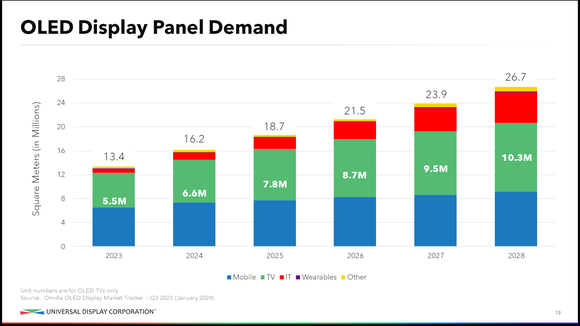Shares of OLED (organic light-emitting diode) display patent holder Universal Display (OLED 1.67%) were heating up again in 2023. Apple's (AAPL 1.06%) don't-call-it-VR headset, the Vision Pro makes use of two small ultra-high-definition OLED displays inside -- but that isn't the reason why.
You see, Universal Display has been developing next-gen materials for OLEDs for many years, and 2024 is the year those efforts start to come to fruition for shareholders.

NASDAQ: OLED
Key Data Points
Blue light is a massive challenge
Universal Display (UDC from here on) is best known as a technology developer and patent holder for all sorts of technologies used in OLED display manufacturing. And via its manufacturing partners, UDC also sells the required OLED materials, specifically organic phosphorescent compounds that emit light when an electrical current is applied to them. The company's revenue is generally about 55% to 60% material sales, and the remaining patent licensing, to display manufacturing partners led by Samsung and LG Display.
To date, much of the OLED market is made up of high-end smartphones. As a result, it's been a tough five years for UDC shareholders. The U.S.-China trade war effects began in 2018, followed by booming consumer electronics sales in the pandemic. Then, consumer demand for OLED-equipped electronics collapsed again in the inflation crisis of 2022.
Along the way, UDC stock's high premium got hit as the U.S. Federal Reserve raised interest rates to fight inflation (higher rates lower the present value of stocks, especially those of growth companies like this one). Through it all, UDC's sales and stock prices have steadily grown, but with a lot of volatility.
Data by YCharts.
Setting the stock aside for a moment, though, UDC is on the cusp of commercializing a huge breakthrough that could keep its financial results headed up and to the right: blue phosphorescent material.
UDC is the only company that sells high-performance phosphorescent red, yellow, and green base materials for OLEDs (or, more precisely, PHOLEDs). But what about blue? Currently, display manufacturers have to utilize older blue fluorescent material in their ingredient list. These older fluorescent materials don't possess the high energy-to-light conversion rate the PHOLEDs do.
Blue light in PHOLEDs is a tough nut to crack, and UDC has been at its development for a long time. But in 2023, it was finally ready. UDC logged $5.6 million in blue PHOLED sales (less than 1% of total 2023 revenue) as its customers began to experiment with new recipes to increase the performance of their OLED displays. Significant growth from these blue PHOLEDs is now expected to start in 2024.
Gearing up for a new growth cycle
Consumer electronics (smartphones in particular) are stabilizing after a year and a half of downturn, which bodes well for UDC. And feathering in the new revenue stream from blue display elements has management forecasting anywhere from 9% to 17% total revenue growth in 2024.
After years of work with display technology, device manufacturers are gearing up to expand their ultra-high-definition OLED screens to include laptops, more tablets, and even automobiles. UDC's management thinks a new industry growth cycle is just starting, with multiple double-digit growth markets (laptops, TVs, autos, and maybe even virtual reality devices like the Vision Pro) joining the smartphone OLED display party through 2030.

Data source: Universal Display.
This could be huge for UDC. Even as it has dealt with the consumer electronics downturn, plus invested in lots of research and development, the business has been cranking out operating profit margins near 40%. It plows a lot of the resulting cash back into its dividend (currently yielding 1% a year).
Data by YCharts.
At 37 times trailing-12-month earnings per share, UDC stock still isn't cheap. However, with growth and earnings poised to make a comeback, 2024 and 2025 could be momentous years for the OLED patent holder. I'm happy to continue holding for the long term, as UDC looks like the best way to ride a coming wave of better display technology in the decade ahead.

